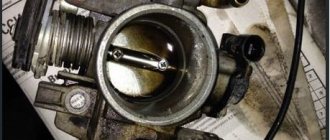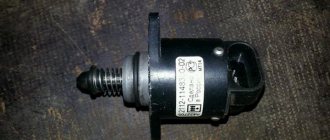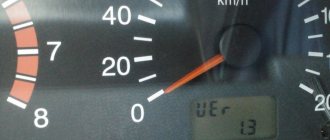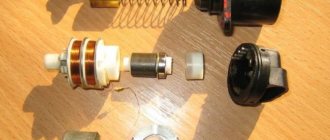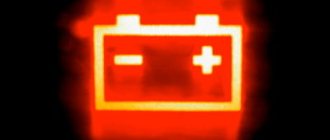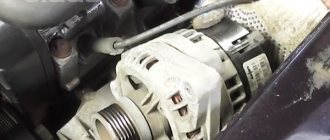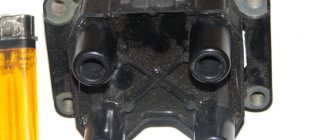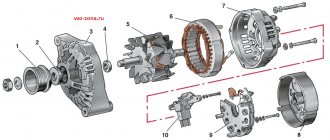If a VAZ-2110 stalls on the road, many drivers are lost and do not know what action to take. It’s unlikely that your car will be repaired on the road, so the first thing to do is get to a service center or your garage.
This problem will occur quite often if you ignore it the first time. You will need to carry out a few fairly simple operations to identify the source of the problem. In extreme cases, you will have to go to a service center for professional help.
If the engine does not start: troubleshooting methods
If the most unpleasant thing happens, you should not make useless attempts and only discharge the battery by rotating the crankshaft. You may still need a charge of electricity if you succeed in repairing the car. At least for the starter to work.
First of all, you need to check whether the fuel pump is working, whether there is enough fuel, whether the ignition works. Maybe the problem is in the injectors that have failed, but this happens very rarely. Their O-rings, vacuum hoses, and gaskets wear out more often. The same goes for the electronic control unit (ECU), for the most part it works properly for a long time.
The fuel pump and its operation are controlled by sound
If it is missing, it is important to ensure that the wiring is in good condition. The sufficient voltage supplied to the fuel pump is 12 V. The pressure created during its operation by the fuel supply system should be about 2-3 bar
The pressure created during its operation by the fuel supply system should be about 2-3 bar.
When fuel stops flowing, the pressure drop occurs over time, not immediately. If this happens almost immediately, then you need to check the fuel regulator, unless, of course, it is leaking. You can turn off the fuel pressure regulator for a short time to make sure the system is working.
All connections that may affect the operation of the computer should be checked. There is a good chance that there is a disconnect somewhere. In this case, a good signal of operability is the illumination of the Check Engine indicator. If it exists, then there is still hope. However, cars produced by VAZ do not allow you to determine the error code and, accordingly, localize the fault without using a tester.
A large number of errors most likely indicates a completely detached part. Next, you should measure the voltage supplied to the network. Typically, a running engine consumes 14 V, its cranking results in a voltage of 8 V, and an idle one - 12.5 V. You should definitely make sure that the drive belt and camshaft are intact, which will not be very difficult.
Finally, you should completely disconnect everything from the ECU except the crankshaft timing sensor, but if you do not understand the actions being performed, it is better not to risk it. If the VAZ 2110 stalls after the work done above, you need to check how clogged the air filter is. If it has not been replaced or cleaned for a long time, it is better to do it right now.
It wouldn’t hurt to check the fuel pump, as mentioned earlier, compare the actual coolant temperature with the sensor readings (a deviation of 5 °C is allowed), as well as the voltage. In addition, it is worth wiggling the various connectors. This may seem funny and absurd, but it happens that the reason is precisely a poor connection. Finally, you should inspect the camshaft belt.
Didn't find the information you are looking for? on our forum.
We recommend reading:
Replacing the float in the gas tank of a VAZ 2107, removal and installation with photo
What gasoline to use in Lada Granta, manufacturer's recommendations
Cooling system for VAZ 2110, 8 and 16 valves, principle of operation, main malfunctions
VAZ 2114 burned out valve symptoms
VAZ 2107 injector, idle speed floats, reasons
Replacing the thermostat on a VAZ 2107
VAZ 2114 how to reset daily mileage on
The interior smells of gasoline, viburnum, the main reasons, how to eliminate
GOOD TIPS
First, let's look at the reasons common to carburetor and injection fuel supply. That is, reasons beyond their control. Anyone who has looked for the causes of problems themselves knows that this is done by the method of elimination. But the law of meanness always works, and the reason is, as a rule, in the last node being checked. Therefore, let's turn to statistics and, based on its prompting, begin to implement the random method.
- If the car runs on a 16-valve injector and stalls, then you need to change the oxygen sensor; it is possible that it is not tightly connected to the connector located on the air filter housing. You should connect it correctly, if this does not help, then you should clean the injectors, since the gasoline now contains impurities, and the injectors become clogged.
- The reason that the engine stalls while driving may be the idle speed sensor (IAC), or more precisely, the idle speed controller (IAC). By the way, if there are problems with the IAC, the engine stalls even at idle. So, you should remove it and start by simply cleaning it. Don't forget to clean the mounting hole on the throttle assembly where the sensor needle goes. After cleaning, you need to check its serviceability. To do this, with the ignition on, bring the power block to the removed sensor; if the conical needle extends, then everything is in order with the sensor, but if not, then the sensor needs to be changed.
- The reason that the car stalled while driving may be due to wear on the rollers or timing belt. In both cases, you need to contact a specialist. This is a serious knot. Giving absentee advice regarding the repair of this unit is, to say the least, irresponsible.
- When you start the car when it's hot, the engine stalls. The crankshaft sensor may need to be replaced. It is possible that the catalyst burned out and a plug formed in the exhaust system.
The list of supposed reasons can be continued indefinitely and one cannot find a reason why the VAZ-2110 stalls while driving, regardless of whether the injector supplies fuel or the carburetor. But this is not a reason to give up. The road can be mastered by anyone walking or driving, you just need to fix the problems in the car. We can say for sure that what will not help you start the engine is kicking innocent wheels and calling the car’s mother an unkind word. Remember, he doesn’t have a mother, he’s half orphan. Please be understanding about this.
There is a special offer on our website. You can get a free consultation with our corporate lawyer by simply submitting your question in the form below.
Didn't find the information you are looking for? on our forum.
If you find an error, please select a piece of text and press Ctrl+Enter.
We recommend reading:
How to raise the front pressure in the cooling system on a VAZ 2110 VAZ How to adjust the steering wheel on a VAZ 2114 Adjusting the rear axle gearbox of a VAZ 2106 at home Replacing the CV joint on VAZ cars with your own hands How to install a pump on a VAZ 2114. Replacing it yourself A VAZ 2114 stalls after releasing the gas Why the cylinder does not work on a VAZ 2105
How to check the serviceability of the throttle position sensor
One of the problems may also be faulty operation of the DPZD. It is this part that is tested last, since the problems described above often arise. However, you should not ignore testing this sensor, because sometimes it helps save a lot of time.
https://youtube.com/watch?v=Yo4iu55VJLE
Here's how to do it correctly:
This sensor is located on the throttle pipe and is connected to the throttle axis. Secured with two screws
When removing the sensor, you should pay attention to the condition of the throttle valve, whether it is coked. If it does, then it will have the same symptoms as with problems arising with the sensor, but it can be checked even without removing
To do this, you need to measure the voltage at the DPSD terminals when the ignition is turned on. It should not be higher than 4B. Then you need to check the voltage at the DPSD terminals while the damper is moving. There should be no changes to it. If there are sudden changes, this indicates that the sensor is faulty.
Now you know what to do if your VAZ-2110 stalls and how to deal with the problems without resorting to the help of professionals and wasting money. We hope that our advice will be useful to you in a difficult situation.
VAZ 2110 injector 16 valves stalls while driving
- To the beginning of the forum
- Forum Rules
- Old design
- FAQ
- Search
- Users
I have a 2112 16 valve. Everything is standard, that is, I haven’t changed/tuned/modified anything.
The car started stalling while driving, 1-2 times a day. But then it started (you only needed to crank the starter for about 3 minutes).
Then the problems started in the morning - it wouldn’t start and that’s it. On Friday it stalled at 23-00. I couldn’t start it. After 15 minutes, while I was running around looking for a tow truck, it started up and after working for 10 minutes (and having driven 2 km) it died. I pulled it home with a noose.
I went to the service in the morning. Xati started up again on its own and drove perfectly. The diagnostician said that his “smart things” found nothing. Just in case, we changed the spark plugs (well, they really asked for it for a long time).
I went home inspired. The next morning it started up perfectly (it doesn't mind frosts). I got to the store (1 km) - went out/returned - started it - drove 50 m and got up again. I abandoned the car and waited at home for an hour for the car that was supposed to take me to the service. But this “bastard” started up again on its own and drove to the service station without any signs of malfunction.
In short, diagnostics again - the result is zero. After all, it works and even the malfunction light in the engine does not light up. The diagnostician said that as soon as the car starts, call immediately, otherwise no one will help you.
Has anyone encountered this? Share - WHAT'S HAPPENING WITH HER.
I would like to note that whenever it did not start,
1) I turned off the immobolizer 2) I heard the fuel pump working 3) the starter spun perfectly, as best it could 3) the light on the engine malfunction on the side was on (that is, this is how it should be, because this indicates that power is being supplied to the system, and the light turns off when the car starts)
that when it works everything is fine
but when not, the starter drives, as if I hadn’t turned off the immobolizer.
that when it works everything is fine
but when not, the starter drives, as if I hadn’t turned off the immobolizer.
I have a 2112 16 valve. Everything is standard, that is, I haven’t changed/tuned/modified anything.
The car started stalling while driving, 1-2 times a day. But then it started (you only needed to crank the starter for about 3 minutes).
Then the problems started in the morning - it wouldn’t start and that’s it. On Friday it stalled at 23-00. I couldn’t start it. After 15 minutes, while I was running around looking for a tow truck, it started up and after working for 10 minutes (and having driven 2 km) it died. I pulled it home with a noose.
VAZ 2110 stalls at idle
Possible reasons for the VAZ 2110 engine stopping at idle
Let's look at one of the common problems for the VAZ 2110 car. This is a Russian-made sedan, usually with a 1600 cc engine and a 5-speed gearbox.
It often happens that when stopping in neutral gear, the tachometer drops the revolutions to 500, and then the readings become standard - 800-900 rpm. After some time, the car begins to stall altogether.
The first thing car enthusiasts do in such a situation is to decide that the problem is that the injectors are dirty and cannot spray fuel as expected. This can happen due to many impurities in gasoline, the quality of which has recently left much to be desired. If the assumption is correct, then the control unit, receiving a signal from the injectors, increases the amount of fuel supplied, which can cause the engine to stop. If after cleaning the injectors the picture does not change, and the car continues to stall when braking at traffic lights and pedestrian crossings, another reason should be considered.
Another “troublemaker” can be the idle speed sensor. You should just replace it and see how the car behaves. If you don’t want to spend money on a new sensor without making sure that the old one is faulty, just ask the lucky owner of a working car for half a day. “Tens” remains a popular model and I think you can borrow this sensor from someone you know. If the experiment showed that the problem is not at all with the idle speed sensor, then you should contact computer diagnostics.
The oxygen sensor may be faulty and the fuel mixture may be too rich. You can also find out the readings of the mass air flow sensor from the diagnostics. With increased voltage, more than 1.01 Volts, the control unit receives false information from it, which may cause the engine to stall. Replacing this sensor will eliminate the problem, and you will continue to operate your “ten” without problems.
Note to managers of public utilities: High-quality Russian special equipment at competitive prices. Auto-hydraulic lifts and aerial platforms - https://autokan.ru
VAZ 2110 injector 16 valves stalls while driving
- To the beginning of the forum
- Forum Rules
- Old design
- FAQ
- Search
- Users
The idle speed sensor is OK.
When diagnosing the engine at the service center, the computer did not show any errors.
Feedback for me, for example, is the only incentive to respond, of any use.
It was so. I went to repair the block head. I hope things aren't so bad for you
INFORMATION MAIL ? 32-2004-I To troubleshoot the problem “The engine stalls when shifting gears?”. On cars of the 2110 family with a 16-valve engine equipped with a 2112-1411020-40 controller and M1V05H07 software, at an air temperature of 0°C and below, the malfunction “Engine stalls at the moment of gear shifting” occurs. This malfunction is associated with low air flows through the idle air regulator in the throttle pipe. To increase leakage through the throttle valve, it is necessary to tighten the stop screw (installed by the manufacturer on the sealant?) on the throttle pipe by 0.5? 1.5 turns. If it is difficult to tighten the screw, you can install a spring bracket 14189776 with a cross-section of 0.2 - 0.3 mm on the throttle valve thrust lever. The specified work must be performed under the control of DST-2 or another diagnostic device with the ignition on, monitoring the voltage on the throttle position sensor (TPS). The increase in leakage can be determined by increasing the TPS voltage by 0.04? 0.06 V from reading to adjustment. It is necessary to ensure that the voltage at the TPS does not exceed 0.65 V and the idle speed with a fully warmed-up engine does not exceed 850 rpm. When owners contact about the specified malfunction, it is necessary to urgently send a request to the OAD. In your request, be sure to indicate the serial number of the controller, software version, date of manufacture and serial number of the controller. In the absence of permission, the work performed will not be accepted. Method for increasing leakage on the throttle pipe: 1. Connect the DST-2M device. 2. Start the engine and warm it up to operating temperature. 3. Using DST-2M, monitor and record the value of the output voltage from the TPS at idle. 4. Turn off the ignition. Place the spring clip 14189776 onto the throttle valve stop lever so that it rests against the adjusting screw on the throttle pipe. 5. Turn on the ignition. Using DST-2M, check the value of the output voltage from the TPS; it should increase compared to the original by 0.04-0.06 V and be no more than 0.65 V. 6. Start the engine. On a warm engine, check the idle speed using DST-2M. They should be no more than 850 rpm. The complexity of adjusting leaks on the throttle pipe is 0.4 standard/hour. Defect coded 1148010 074 000 ?Adjusting leaks on the throttle pipe?.
Reasons why a car won't start
Typical reasons for the VAZ 2110 are as follows:
- The ignition timing is broken (8 valves);
- Malfunctions of the gas distribution mechanism;
- Incorrect connection of the security system, as a result of which standard modules block the flow of current to the coils;
- Failure of spark plugs;
- Damage, defect of crankshaft and camshaft sensors (16 valves);
- Fuel pump clogged;
- Clogged cleaning element;
- Low battery charge.
The above list is not exhaustive and may be supplemented with new factors in each situation.
If you have experience and skills in servicing the equipment, proceed to troubleshooting yourself. Otherwise, seek help from service station specialists to carry out diagnostics using digital equipment.
Troubleshooting options
It is clear that if any emergency situations arise with the motor, it is advisable to contact a specialized service. However, this procedure is not always possible. Therefore, it is worth knowing how to independently diagnose the main systems and key parts.
Throttle valve and assembly
When the speed drops at idle and the car stalls, you need to pay close attention to the details of the throttle assembly. Long-term operation of the car on low-quality fuel, untimely maintenance of the air filter can lead to malfunctions of the throttle valve
It periodically jams if debris gets into the equipment.
Throttle valve VAZ 2112
The problem can be solved by cleaning the system. The throttle is cleaned using carburetor cleaners. Using a compressor, you need to blow out the damper under the pressure of compressed air. It is not recommended to touch the screws located inside and on the side. If cleaning does not correct the situation, the device must be replaced. This operation is not particularly difficult.
Crankcase malfunction
There is an oil trap in the crankcase ventilation system of the engine. Its contamination can also lead to interruptions in engine operation. Crankcase gases do not allow the engine to function normally, the speed fluctuates, the internal combustion engine stalls.
Sensors
If a gasoline car stalls at idle, then one of the sensors is likely to break. In injection cars with an electronic engine control system, the engine usually starts normally, but then it stops working. It's worth checking here:
- Electronic car indicators;
- DRХХ – device that regulates idle speed;
- Air flow meter (air intake in the carburetor);
- Sensor indicating the position of the throttle curtain.
Electronic control unit in VAZ 2114
Interruptions in the operation of any sensors immediately affect the behavior of the electronics - errors appear in the car control unit. The “brains” of the machine receive unreliable information. It is not transmitted correctly to the engine. It starts working with parameters that do not correspond to reality. Self-testing of this device is not possible. You need to contact a professional for service.
Diagnostics of mass air flow sensor
The idle air control device is usually to blame for engine malfunction when the car idles poorly. But you pressed the gas pedal and the engine started. In the latest VAZ modifications, error information appears on the instrument panel.
When diagnosing, you must use a multimeter. If a part is faulty, it is recommended to replace it with a new one. All sensors are reasonably priced. It is better to start checking with parts that have a simpler design. Then gradually move on to complex devices. We must not forget that the problem may lie not only in the sensors themselves. It is also necessary to check the wiring to them and the presence of stable contact.
Carburetor
If the VAZ carburetor stalls at idle speed, then the jets may become clogged. Low-quality gasoline, deposits from the gas tank, contain small particles of debris. They can easily disrupt the operation of the fuel injection system. It is worth replacing the filter in front of the carburetor and cleaning the device itself. The dispensing part is cleaned using a cleaning solvent, which is sold in aerosol cans. Another reason is often a prolonged lack of carburetor adjustment.
In a mechanical fuel pump of carburetor cars, the filter mesh may be clogged with dirt. This reduces the performance of the device. Wear of the membrane and its destruction often leads to clogged carburetor channels.
Methods for diagnosing the idle air regulator (IAC)
The most common cause of the described problem, as well as the fact that the car cannot be started at all, is a malfunction of an engine part such as the idle air control. This happens most often on domestically produced cars. There are several possible situations where an IAC malfunction may occur. While the car is moving, a short-term stop occurs, as a result of which the engine stalls when hot immediately after it starts, or refuses to start at all.
After the engine has started, normal idle speed is restored only when the gas pedal is pressed at least once. Observation of similar behavior is possible with a cold engine. The initial attempt to start the engine is unsuccessful, normal operation is restored only after pressing the gas pedal.
In different situations, it may be enough to either press the pedal once or hold it until the engine warms up. An IAC malfunction may occur during sudden braking, when the engine stalls unexpectedly, and restarting shows a normal idle speed above 1500 and within 2000 rpm.
If this is the case with your car, you can try washing the IAC and throttle assembly using a special solution. If the problems do not go away, the idle air control will have to be replaced. Over time, some components may wear out naturally.
A VAZ with an injector starts and immediately stalls
A few reasons:
- Fuel-injected cars may behave this way due to a faulty fuel pump. It's in the tank. It is very easy to check its functionality. If you turn the ignition key to the first position and listen, you will hear the pump working, pumping gasoline into the system.
- Severe contamination of the fine fuel filter can also cause the car to stall after starting. The filter simply does not have time to pass the required amount of gasoline.
- ECU errors quite often lead to problems with starting the engine, not receiving signals from certain sensors, or receiving them in a distorted form. It is best to diagnose such breakdowns in specialized services.
Why does the car stall?
There are many problems with the VAZ 2110, both injection and carburetor, in which the car can constantly stall.
Moreover, the true causes of this misfortune can be searched for a long time and persistently, without solving the issue on your own. But still, you can perform some steps yourself to try to solve the problem.
If we think globally, problems may arise in the following car systems:
- Ignition system
- Fuel system
- ECM
Now it is worth considering each of these systems in more detail.
Ignition system VAZ 2110
So, if the car stalls due to problems with the ignition system, then first of all you should pay attention to the cheapest elements, such as spark plugs and high-voltage wires. If after changing these elements the problem does not go away, then the reason that the car stalls may be a malfunction of the ignition coil or module.
Usually, if a module or coil malfunctions, one or even several cylinders begin to fail, which can lead to similar symptoms. If you have a carburetor car, then in this case you need to check the functionality of the distributor, coil and switch.
Fuel system VAZ 2110
The power system also contains many elements that are responsible for the normal operation of the engine. Difficulty starting, failures when moving or pressing the gas pedal, floating speed or even interruptions in engine operation - all this can be the cause of a malfunction in the fuel system.
First of all, you should check the fuel level in the tank and add fuel if necessary. But in 99% of cases the reason lies elsewhere. Check the fuel filter, which is located in close proximity to the gas tank. If you haven’t changed it for a long time, say more than 30 thousand km, then I highly recommend doing it.
Also, close attention should be paid to the condition of the strainer, which is located in the fuel pump module of the VAZ 2110. If it turns out that it is clogged, you need to replace the fuel pump strainer with a new one.
Insufficient pressure in the fuel rail can also be the reason why your car stalls. Moreover, this can manifest itself both when the engine is idling, and while driving, when the engine speed is increased. To solve the problem, you need to replace the fuel pump.
ECM
If one or more sensors malfunction, the car may not start at all, let alone simply stall. For example, when the mass air flow sensor fails, the engine speed becomes unstable and can fluctuate in unacceptable ranges from 500 to 2000 rpm, without any action on the part of the driver.
Phase sensor, throttle position sensor, idle speed control - all these elements can also play a negative role in engine operation. And if you can somehow sort out the fuel system or ignition yourself, then in the case of the ECM it is better to contact an experienced specialist who will carry out diagnostics and identify the cause.
Source: https://remont-vaz2110.ru/pochemu-gloxnet-mashina/
Problems with Solex carburetors
In addition to all of the above, engine speed drops if the fuel level in the carburetor (float chamber) is incorrectly adjusted. As a result, there is either not enough gasoline in the fuel mixture or too much of it. When adjusting the VAZ 2107 carburetor, it does not need to be disconnected from the engine.
Follow these steps:
- remove the air filter housing by unscrewing all fasteners;
- remove the carburetor cover;
- check the position of the floats. To do this, separate and bring them together to achieve the correct location.
It is necessary to achieve such a position of the floats so that they move freely without clinging to the walls of the chamber in which they are located. It will not be superfluous to measure the distance from the protrusions on the floats to the paper gasket. The distance should be within 0.75–1.25 mm. Use a feeler gauge to measure.
What to do if it is far from normal? In this case, you need to adjust the height of each of the floats.
As we have seen, there are many reasons why the engine stalls. To start the engine correctly, you need to check and eliminate all the above faults. Afterwards, if the problem is not resolved, you will have to contact specialists.
What to do if the VAZ injector starts and stalls at idle? This problem most of all concerns old cars, since with age various contaminants accumulate in the fuel system and in the vehicle, as well as sensors and mechanisms wear out - all this will inevitably lead to changes in engine operation.
We will describe in order all the reasons that lead to this problem.
The first thing to check is the mass air flow sensor (MAF). The sensor's sensing element becomes dirty and wears out with age, which is why its resting voltage increases and its reaction time to changes in air flow increases. If the quiescent voltage exceeds 1.035V, you should think about replacing the sensor, because it will no longer be able to give inflated readings on air flow. The electronic control unit will supply more fuel and the mixture will be over-rich - and this will have a very bad effect on all engine operating modes, as well as on idle stability. The idle air control (IAC) can also affect the stability of the engine. Rod jamming is the most typical malfunction in it. In addition, with age, natural wear and tear occurs on the components of the regulator, and this leads to problems with movement. The usual service life is 100-150 thousand km. Only with the help of special equipment can you check the IAC, and it is better to replace it with a new one immediately if a malfunction is suspected. Very often it is enough to simply clean the throttle assembly from dirt. It's easy to do it yourself
These are the most basic cases that you need to pay attention to. Atypical situations will follow. Sometimes the problem is a leaky intake manifold.
You need to check the gaskets, vacuum hoses, injector O-rings, and the vacuum brake booster and manifold plugs. The easiest way to find air leaks is with a smoke generator. Pay attention to fuel pressure. You also need to check the ignition system and spark plugs in particular.
In conclusion, it should be noted that without special equipment, a complete check of the system is impossible. Only with its help can the fault be accurately identified.
During the operation of a car, a common situation is that after turning the ignition key, the car starts, the engine starts to work and stalls after a few seconds. As a rule, 3-5 seconds pass from start to stop. Before the engine stops completely, it is also noticeable that the power unit shakes and works very unstable.
This happens as a result of a decrease in speed, the resonant effect of the rotating one, etc. When you try to start the engine again, the engine may no longer start, or the situation described above may repeat again.
The reasons for this problem vary. The main thing is that if the car starts and stalls, this indicates that in-depth diagnostics are needed. Next we will talk about what to do in such a situation, as well as how to find the reason why the engine stalls after starting.
Read in this article
Signs and solutions to problems
Below we will look at the most common signs when a car stalls at idle.
The car starts and stalls immediately after the starter is turned off.
- When a car suddenly stalls at idle, the most common reason is that the throttle valve is dirty, causing it to become clogged and sticky.
This problem is solved by simply cleaning it, using a carburetor cleaner from a bottle. This happens due to the use of low-quality fuel and the presence of large contaminants entering through the air filter (for example, oil). This is what a dirty damper looks like. - It is also worth paying attention to the presence of contaminants in the oil trap system in the engine crankcase. Because if this filter is dirty, the engine will simply stall from excess crankcase gases.
The car starts and immediately stalls
Checking the MAF sensor readings
The cause of a malfunction with such symptoms is most often the above-mentioned sensors: IAC (idle air control), MAF (mass air flow sensor). Before purchasing new parts, you need to disassemble them and check for contamination. Also check the mass air flow sensor for the main signs of malfunction. However, if you have the opportunity to check the malfunction using diagnostic equipment, then do not deny yourself this. Read more about replacing the IAC here, and about replacing the mass air flow sensor here.
The functionality of all sensors should be checked in order, starting from the least structurally complex to the most.
Checking relays and ECUs and other sensors
- It may be necessary to remove the fuel pump to check. You will need to remove the rear seat and check the voltage at the pump terminals. The device should show + 12 volts. Then crank the engine using the starter. When it is triggered, they proceed to subsequent actions. It may happen that when you turn the ignition key, the starter does not turn. Then you need to check the reliability of all wires on it. The cause may be a problem in the contact group in the ignition switch.
- If it is determined that everything is in order, check the spark on the spark plugs. To do this you will need to open the hood. First, you need to unscrew the spark plug from the first cylinder. It is necessary to throw an armored wire over it and press it against the mass. In this case, the candle must be held with pliers and not with your hands. Otherwise you will get an electric shock. At this time, the assistant starts the engine. All other candles are checked in the same way. If there is a spark on each cylinder, it is necessary to look for ignition problems.
- The situations may be different, for example, a spark is present on cylinders 1 and 4, but not on cylinders 2 and 3. The ignition module should be replaced. If the replacement does not give a positive result, you should look for the reason in the output transistor switches to the ignition module from the ECU. The ECU may need to be repaired.
- It may happen that there is no spark on any cylinder. VAZ 2110 does not start because there is no spark. Often the reason for this lies in the crankshaft position sensor. The DPKV ECU gives a signal through which pulses are sent to the ignition module so that a spark is formed. The cause of the malfunction may be the lack of connection between the gear and the generator wheel. This can occur even if the DPKV is in full working order. At the same time, the crankshaft rotates, but the sensor will not process these rotations. Many are frightened by the fact that the VAZ 2110 injector has a large number of sensors. Indeed, there are a lot of them, but the reason that the VAZ 2110 does not start the first time is only one thing - the DPKV sensor is faulty.
- It is necessary to unscrew the spark plug from the cylinder and check its moisture content. A dry spark plug indicates that the injector is not spraying fuel. Then check the pressure in the fuel rail. It has a special bolt on the side. It must be unscrewed and a pressure gauge inserted in its place. It will show the presence or absence of pressure in the ramp. But it may not be at hand. Then the bolt is unscrewed and the pump starts. If there is pressure in the ramp, a good stream will flow out of the hole.
- If there is no pressure, the fuel filter must be replaced. The reason may also be that the line on the way from the fuel tank to the ramp is clogged. If the unscrewed candle turns out to be wet, then they all need to be unscrewed, wiped and dried thoroughly.
- Sometimes the reason is that the injectors are clogged and need to be cleaned. Clogged injectors may cause the spark plugs to be flooded with fuel. Dirty injectors are often the reason why a car engine has difficulty starting.
- Sometimes the reasons that the VAZ 2110 16 valves does not start may be of a deeper nature. They are very difficult to diagnose. But for the VAZ 2110 this is the exception rather than the rule.
Testing the mass air flow sensor
VAZ-2110 with 8 valves and an injector stalled. The question immediately arose - what to do in this case? If the cause of the problem is not the IAC, then the mass air flow sensor should be tested.
Below are some tips on how best to do this:
- First, disconnect the connector at the sensor from the on-board system. The engine is controlled by a controller, and after this action it will begin to operate in emergency mode; this is not dangerous during a short test. If the car becomes faster, then most likely the cause is the mass air flow sensor, and it’s time to clean it.
- You should replace the damaged sensor with a properly working one, and then see how the engine performs. If it gets better, you need to clean or replace your own mass air flow sensor.
- Carefully inspect the air intake. To do this, you need to remove the clamp responsible for the fasteners and inspect the air intake from the inside. There must be no oil or condensation there. If any of this is detected, you need to clean the air intake with special means.
- You can test the mass air flow sensor using a multimeter. You need to change the operating mode to the voltmeter and set the second level. On the sensor you will see two wires - green and yellow. The yellow wire serves to transmit signals to the controller, and the green wire transmits ground. Then you need to turn on the ignition and take measurements between these wires. The engine must not be running during this process. If the readings are at the level of 1.01-1.02, then the sensor is in perfect order. If the readings range from 1.02 to 1.03, it’s time to clean the sensor, and if it’s higher, it’s time to replace the sensor with a new, working one.
These tips will help you understand the possible reasons for the malfunction of the mass air flow sensor and the car's plug. As you can see, it is not difficult to do this yourself, without contacting a car service.
The car stalled - procedure
First of all, don't waste your battery trying to start your car. It may still be useful if you manage to start the engine. Next you should check:
- Is the fuel pump working?
- availability of gasoline;
- correct ignition.
Sometimes the injectors become clogged. However, usually the problem is their:
- gaskets;
- seals;
- vacuum hoses.
It is extremely rare for the ECU to fail.
The serviceability of the fuel pump is checked by ear - during operation it makes a characteristic sound. You need to listen in the back seats.
Next, you need to make sure that the wiring is working properly. The pump is supplied with 12 volts. The normal pressure for it during fuel supply is up to 3 bar. When the engine is turned off, it gradually decreases - an instantaneous drop indicates a breakdown of the regulator or a leak. It is imperative to check the reliability of the connections of the wires and their connectors - the latter often come loose due to vibration.
Failure of the sensors leads to incorrect operation of the ECU. However, if there is a red light on the panel indicating problems with the engine, most likely the computer is fine.
The battery is working properly and produces 12.5 volts at the terminals. When the engine starts, its voltage drops to 8. If these values are lower, then the battery needs to be charged or replaced.
Why does it start and stall?
If you turn on the logic, there may be several main reasons why the engine stalled after starting:
- insufficient amount of fuel;
- exhaust system malfunctions;
- failures in the formation of the air-fuel mixture and its supply to the injectors.
It can be assumed that the cause is faulty spark plugs or a clogged air filter. But spark plugs do not all fail at once. If one spark plug does not work, the engine starts to stall, but this will not cause it to stall. To clog the filter to such an extent that it is unable to pass air through itself requires a lot of effort. When there is no air supply, the engine will not start at all, and even if it does start, the thrust will drop significantly. Traveling would be difficult, if not impossible.
Insufficient fuel supply
The symptom is simple: after starting, the engine runs for 5–10 seconds and stalls. In most cases, the cause is the fuel pump located in the fuel tank. To be precise, the problem is a clogged fine filter or mesh. This detail, insignificant at first glance, does not allow dirt particles to enter the fuel line, which, like water in the gas tank, is abundant (especially on cars with a mileage of 50,000 or more).
In summer, the water and other substances in the tank are liquid and can pass into the main line, but in winter they often turn into ice on the mesh filter. This causes the fuel pump to be unable to pump enough fuel to run the engine. Therefore, it turns out that the pump manages to pump a little fuel, and this is just enough to start the engine, but no more. To eliminate this problem, it is enough to replace or clean the fuel pump mesh.
Occurrence of a problem
Engine problems in the VAZ-2110 arise for various reasons. The result of a malfunction of one of the nodes associated with the engine will be unstable operation of the entire node.
Not everyone can independently identify the reason why the car stalled, so it’s worth paying attention to some little things.
One of the main problems with cars with high mileage is contamination of the system with fuel combustion products, so a simple lack of cleaning can eventually cause the engine to stall.
If the pipes are clogged, fuel enters the combustion chamber in small quantities; it is not enough for normal engine operation. The solution to this problem is simple - check all the fuel channels, clean them, replace the fuel nozzles. For carburetor types of VAZ, this will not only solve the problem, but also improve engine performance.
The second reason why the engine may stall is low-quality gasoline. An incorrectly selected brand of gasoline can have a very detrimental effect on many vehicle systems, including the engine. You need to replace the fuel, this will help solve the problem.
These solutions to the problem are simple and require minimal skill and expense from the driver.
Incorrect engine operation at idle
More questions arise if the engine suddenly stalls at idle. There are several possible faults that could cause this type of problem. You can check all of them yourself in your garage.
The first thing to check is the idle speed sensor. Since it is connected to the engine, its incorrect readings can disrupt the system. It is worth checking that it is connected correctly and is working properly. The device must be replaced if there is damage to the housing.
It is very easy to check the functionality of the sensor:
- Turn on the ignition; if the starter is unable to accelerate the engine, press the gas several times.
- If the engine starts after pressing the pedal, release it and observe the operation of the motor.
- If it stalls, you can be sure that the idle air control valve needs to be replaced.
No less problematic is the throttle valve assembly. If it is clogged, similar problems arise as when the fuel channels are clogged, and the engine sometimes stalls. Clean the throttle valve.
If this does not solve the problem, check the condition of the throttle sensor. Its malfunction also leads to incorrect operation of the engine unit, so replacement or repair will help solve the problem.
Problems on the go
Now it’s time to deal with the problems that arise on the road. It happens that the engine stalls while driving. In this case, it is best to call a tow truck or enlist the help of other drivers to deliver the car to a garage or the nearest service station.
If you have some skills in handling cars, then you can check several suspected problem components and parts yourself:
- Spark plugs - they are almost always checked. If they are not working, replace them with new ones.
- A dirty fuel filter blocks the flow of fluid, resulting in a lack of fuel causing the engine to stop working. Check the filter, clean or replace it.
- The air filter may also become clogged. If this is the problem, you will notice not only unstable operation of the engine unit, but also a significant decrease in engine power, which occurs due to the fact that there is not enough air to create a high-quality combustible mixture.
- Serious problems can arise if the fuel pump is faulty. Insufficient pressure appears in the system, and the car begins to stall due to poor fuel flow into the combustion chamber. Check, repair or replace the part.
- The battery is another element that is very rarely checked after the engine is stopped. The operation of electronic devices rests on it; as soon as it is discharged, the machine will stop. The contacts of the device may also be oxidized, but they can be easily cleaned.
- After the battery, it is worth checking the generator. This could be the reason why the battery is discharged. The battery will have to be charged, and the generator will have to be repaired or replaced with a new one.
Conclusion
The last and not the most obvious problems can arise in the carburetor and starter. Even a warm engine can stall if the temperature of the operating unit is very high. This happens especially often in the summer. Just press the gas pedal a few times and the engine will start. Updating the cooling system should help.
The last possible culprit is the starter. Its malfunction causes the engine to stop and not start. You need to check the connection and contacts of the device. If they are ok, replace the device with another one.
The most unobvious culprits for problems may be various sensors that are disconnected from the system.
A small glitch occurs, which ultimately leads to various breakdowns. The easiest way to identify problems with sensors is to send the car to a car service center.
Source: https://korchim.ru/biblioteka/dvigatel/vaz-2110-zagloxla-2.html
What other breakdowns of the VAZ 2107 can occur?
Another common problem that causes the engine of VAZ 2107 cars to start and stall is excess air getting into the carburetor. In this case, the fuel mixture cannot keep the engine running for a long time, and although the car starts, it stalls after a few seconds. It is necessary to determine the location of the air leak and eliminate the gap.
It happens that the jets and pipes of the dosing system become clogged. This also affects the drop in engine speed, so that the VAZ 2107 stalls after a few seconds. What to do in this case? You need to unscrew the jets and pipes under the carburetor cover and clean them. After this, blow out the wells and jets with compressed air. If you have a Solex carburetor, then you also need to clean and blow out the fuel jets located at the bottom of the wells.
Cleaning or replacing IAC on a VAZ-2110
Initially, buy a carburetor cleaner and you can get to work.
- Disconnect the wire block from the sensor.
- Unscrew the two fasteners to remove the assembly.
- If necessary, completely clean the device from any dirt on the cone needle and spring.
- Do not bypass the seat on the throttle assembly; it also needs to be cleaned. Upon completion of the procedure, put everything in its place.
- If after the cleaning measures nothing has changed, all the symptoms of breakdowns remain, then the best solution would be to simply replace the regulator.
The process of replacing the sensor is also quite simple:
- Disconnect power from the battery.
- Disconnect the power supply from the regulator.
- Unscrew the fastening screws and remove the sensor.
- Installing a new device occurs in the reverse order.
Step-by-step replacement procedure
The replacement procedure is carried out in almost the same way as cleaning the device, but there are certain nuances:
- The battery is disconnected to prevent a short in the wiring.
- The plug with the electrical circuit is disconnected from the control device. If the car is equipped with an injection power unit, then to disconnect the connector you need to press on the plastic fastener.
- The bolts are unscrewed. As when cleaning, first unscrew the left fastener, and then the right one. The failed regulatory device is being dismantled.
- The surface on which the sealing element is mounted is also cleaned. The latter is checked for defects - abrasions, cracks, etc. If they are present, the sealing gum is replaced with a new one. Before installation, the seal is treated with engine fluid, after which it is mounted on the throttle seat.
- The controller is installed, a connector with wires for its power supply is connected. A wire is connected to the battery.
- After installation, a calibration procedure is performed. The microprocessor module must perform this independently; an electronic relay is used for this. To calibrate the new sensor, the ignition is turned on for a few minutes and then turned off. If the actions performed helped and the speed no longer floats, but remains at the same level, then the replacement procedure can be considered complete.
What do you need to know when replacing the IAC?
To change and install a controller that allows you to regulate idle speed, you need to pay attention to the position of the rod. It must not be allowed to be pushed forward too much. This can happen if the device is connected to the block and the ignition is activated before installation. It is not allowed to push the rod in by hand.
If the valve is installed with the needle extended and the retaining screws are tightened, damage to the unit may occur due to shearing of the worm gear. It is impossible to repair such a sensor. Depending on the vehicle model, after installing a new regulator, it may need to be calibrated. In some cars, this procedure is carried out using special equipment or a stand.
On VAZ cars, calibration is performed as follows:
- A terminal is connected to the negative output of the battery.
- The key is turned in the lock to turn on the ignition for ten seconds. There is no need to start the power unit.
- The ignition is turned off.
Learning to distinguish a fake from an original
Today, many people complain about the abundance of counterfeit products on the auto parts market.
If we talk specifically about the XX regulator for the VAZ 2110, then there are several key signs by which a fake can be distinguished from the original. Be guided by these data so as not to accidentally install a device of dubious quality and origin on your car.
Fake and original
- On fakes, the black body made of metal is 1 millimeter shorter than the real part.
- In the case of the fake, the three white rivets on the case have no heads. They must be present in the original. And the diameter of the caps is 3 millimeters.
- On fakes, the spring is made in white and has more frequent winding. In the original, the coiling is less frequent, and the spring itself is black.
- Pay attention to the rubber ring of the regulator. On fakes it is black and thin, but in the case of a real part, a reddish tint is noticeable. Plus the thickness is greater.
- Take a closer look at the tip. In fakes it is darker compared to the original spare part.
- There are no markings on the counterfeit packaging; the boxes are noticeably different in appearance.
- The original yellow sticker located on the case must have an outer frame. Manufacturers of counterfeits apparently forgot about it.
As you can see, recognizing a fake is not difficult. You just need to be more attentive to details.
The difference is in the boxes
